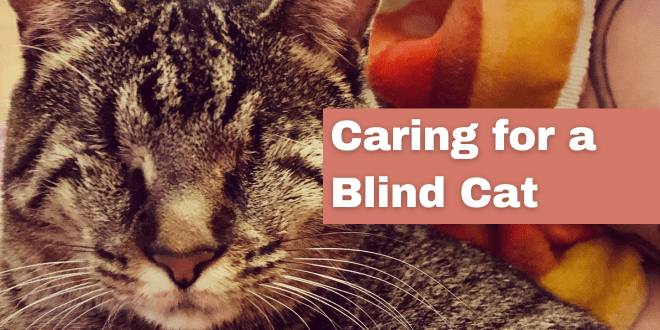
The thought of caring for a blind cat may initially seem overwhelming, but with a few environmental modifications, a little patience, and TLC, your cat can confidently navigate their environment.
Cats can be born blind, or the blindness may be the result of illness, injury, or it could be age-related.
Understanding What’s Needed
When vision loss is gradual, it gives the cat time to adjust to the decline. Many cats learn to navigate so well that some cat parents are surprised to learn there is a vision issue at all.
A cat without vision will rely on his other senses for navigation. Your responsibility will be to provide a stable, safe, and consistent environment. Changes should be minimal to help maintain safety, comfort, and confidence.
Identification
If your cat accidentally gets outside, it will be more difficult for him to find his way home. If your cat isn’t already microchipped, have that done at the veterinary clinic, even if you already have a collar with ID. If you have a collar with a tag, indicate on the tag that the cat is indoors only and blind.
Maintain Consistency
Let’s start with the resources a cat relies on daily. Don’t move litter boxes, food and water bowls, pet beds, or scratching posts unless their current locations now pose a hazard to the cat.
If you have a strong desire to frequently rearrange furniture, then you may have to satisfy that urge by helping a neighbor rearrange their own furniture instead. The furniture placement in your home should remain unchanged, if possible. By minimizing furniture placement changes, this helps your cat establish a mental map of the interior layout and reduce disorientation. Of course, you may need to make some placement changes at some point or replace pieces, but do so carefully so you can guide your cat through the process.
Minimize Household Obstacles
Go through your home, room by room, and make sure it’s free of clutter and possible hazards that a blind cat could encounter. Ensure there are clear pathways without obstacles that could cause injury as well as create confusion. This would be the perfect time to encourage family members to pick up after themselves and not leave things around, as well as pushing chairs in when they get up from the dinner table or leaving backpacks in the middle of the room when they come in from school.

Photo by Jana Shnipelson on Unsplash
Use Textures as Navigation Markers
Use textural markers to help the cat recognize that he is approaching resource areas. Place a mat in front of the litter box, the scratching post, and favorite napping area. This helps a cat detect those cat-friendly areas. You can also use different textured mats to indicate to the cat he’s approaching a potential hazard.
Litter Box Comfort
In addition to placing a textured mat in front of the litter box, create a set-up that’s easy for a blind cat to access. The box should be uncovered and low-sided for easy entry and exit. If you’re concerned about overspray or poorly aimed elimination attempts, place mats under and around the box.
Block Access to Stairs and Other Hazardous areas
A baby gate at the stairway is a practical solution. You can also add extra warning by placing a mat with a different texture at the gate to give your cat a heads up that the stairs are nearby.
Create Scent Markers
If your cat is new to the environment, use his own pheromones as scent markers. Don’t use essential oils or any other scented products such as plug-in air fresheners. Place a sock on your hand or use a soft cloth and gently rub your cat along the checks to collect the facial pheromones. These are the pheromones connected to familiarity and comfort. Once you’ve collected those pheromones, rub objects in the environment such as wall corners, table legs, etc., at about 6-8 inches up from the ground (approximate cat nose height). Repeat every few days as your cat becomes acquainted with the layout. If you bring new furniture pieces into the home, take the time to “scent” them with the cat’s facial pheromones as well by using the sock technique.
If you notice what appear to be dirty areas on wall corners or doors that are at the approximate height of your cat’s cheeks, don’t clean those spots. Those are the areas where your cat has repeatedly cheek rubbed and left facial pheromones. Those scent markers are comforting and valuable to your cat.
Soften Sharp Corners
Use baby safety corner guards to protect your cat from the sharp corners of furniture. You most likely won’t have to use them indefinitely but having the guards in place as your cat adjusts will reduce the chance of injury.
Bells on Collars for Other Companion Animals
If you have a multipet family, attach a bell to their collars to provide an audible alert to their nearby presence. If you have a dog whose collar has a couple jingly tags, that could also serve as enough of a movement warning system for the blind cat.
Vocal Guidance and Reassurance
Speak to your cat frequently to provide comfort as well as assisting in locating you. Some cats require more closeness from the cat parent when there’s vision loss, and hearing your soothing voice will provide that extra security.
Avoid Startling Your Cat
While we’re on the topic of using your voice for comfort, keep in mind that a blind cat startles more easily so announce your presence before petting or reaching over to pick your cat up. This is for the benefit of both the cat and you. A startled cat is more inclined to react negatively by swatting or biting.
Picking up Your Cat
If you pick up your cat, place him back down where he was, if possible. If you must pick up your cat and move him to another location, place the cat in a location where he can quickly orient based on scent or texture. For example, place the cat near the feeding station or litter box, or on a surface where there is a textural marker.
Playtime With a Blind Cat
Your blind cat still needs the opportunity to stalk, pounce, and capture. Regular interactive play sessions are beneficial, along with opportunities for solo play. Fun is an important aspect of a healthy life. Just because your cat is blind doesn’t mean he should lose out on this natural, enriching behavior.
Toys that make some noise will work best, as well as ones that are scented. Incorporate the use of puzzle feeders to help your cat use his sense of smell to manipulate the toy and get the food reward. Use catnip-infused toys to also entice playtime through your cat’s sense of smell. If your cat doesn’t respond to catnip, try silver vine.
Ensure the area where you play with your cat is open enough so he can fully enjoy the game without the fear of crashing into an object.
Training Your Cat
Your cat is capable of learning and it’s important to incorporate proper training, especially if your cat is young or new to the household. Clicker training is a very effective technique for all cats, and since the traditional clicker uses an audible marker, it’s perfect for use with a blind cat.
Create a Sanctuary Room
If your cat is having too much trouble adjusting to the home environment or if other animals in the home are making it stressful, set up a safe room so your blind cat has a place to relax and feel comfortable. You can then begin a gradual reintroduction that isn’t overwhelming.
Be Patient and Compassionate
As your cat’s vision changes, there may be behavior changes as well. Your cat may start to interact less with the family, and seek out hiding places, or your cat may become clingy, more vocal, and start following you around. Be patient and offer plenty of TLC to guide your cat through this change in life.
Need More Information?
If you suspect your cat’s vision is changing or notice anything abnormal with the eyes, contact your veterinarian immediately.
Behavior changes often are due to underlying medical issues so always consult your veterinarian before assuming it’s just a behavior problem. Don’t wait when it comes to your cat’s health.
For more information on cat behavior and training, check out the best-selling books by Pam Johnson-Bennett. The books are available at bookstores as well as online. We’ve included Amazon links here on our website.
This article is for general information purposes only and is not dispensing medical advice or to be used as a medical diagnosis. This information is not to take the place of your cat’s individual veterinary care. Consult your veterinarian if you have questions or concerns regarding your cat’s health and care.
 Problem Solving & Advice by Pam Johnson-Bennett Cat Behavior Expert & Best-selling Author
Problem Solving & Advice by Pam Johnson-Bennett Cat Behavior Expert & Best-selling Author




